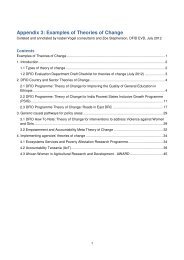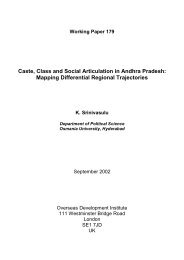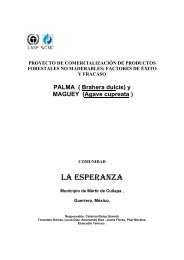Full Report - Research for Development - Department for ...
Full Report - Research for Development - Department for ...
Full Report - Research for Development - Department for ...
You also want an ePaper? Increase the reach of your titles
YUMPU automatically turns print PDFs into web optimized ePapers that Google loves.
second stage previously described <strong>for</strong> electronic databases. References from<br />
handsearching were compared with records stored in the first EndNote bibliographic<br />
database and screened <strong>for</strong> inclusion, as <strong>for</strong> references from websites searches.<br />
2.2.4 Characterising included studies<br />
We first created and entered into EPPI-Reviewer 4 a coding tool to extract and<br />
record in<strong>for</strong>mation on generalities, context, intervention, study design, outcomes,<br />
findings, comments, quality assessment and meta-analysis inclusion (Appendix 2.5).<br />
2.2.5 Identifying and describing studies: quality assurance process<br />
Two reviewers screened the results of searches independently. Be<strong>for</strong>e starting<br />
screening, a cross-check on a sample of 100 references was conducted to test <strong>for</strong><br />
inter-reviewer variability, and where there was disagreement on inclusion, reviewers<br />
consulted with each other until consensus was reached. When consensus could not<br />
be reached, a decision was made after discussion by the team as a whole.<br />
Included studies stored in EPPI-Reviewer4 were randomly allocated to reviewers <strong>for</strong><br />
coding. Reviewers coded the results of searches independently. A cross-check on<br />
coding was conducted to test <strong>for</strong> inter-reviewer variability, and where there was<br />
disagreement on inclusion, reviewers consulted with each other until consensus was<br />
reached. When consensus could not be reached, a decision was made after<br />
discussion within the team.<br />
2.3 Methods <strong>for</strong> synthesis<br />
2.3.1 Assessing the quality of studies<br />
We reviewed the quality <strong>for</strong> quantitative and qualitative studies making use of new<br />
revised guidelines <strong>for</strong> both quantitative and qualitative studies published by the<br />
National Institute <strong>for</strong> Health and Clinical Excellence’s Centre <strong>for</strong> Public Health<br />
(2009). In the case of quantitative studies, these checklists (Appendix 2.6) allowed<br />
us to separately make an assessment of internal and external validity using objective<br />
criteria. In terms of external validity, we assessed whether the source population or<br />
study area was well described, whether the eligible study population was<br />
representative of the study population or study area and finally whether the actual<br />
participants were representative of the study population. We evaluated, <strong>for</strong><br />
example, whether studies used theoretical perspectives, had clear aims and<br />
discussed the limitations and possible biases. Most of the evaluation of the methods<br />
concerned: whether the randomised controlled trial or the baseline of quantitative<br />
or review methodologies were laid out clearly, <strong>for</strong> instance, the methods of<br />
randomisation, participant blinding, sample size based on power calculations to<br />
detect significant effects; and whether the conclusions were appropriately justified<br />
by the methods and data. If most of these criteria were fulfilled, then the analysis<br />
would be judged to have a high degree of internal validity (++); if some of the<br />
criteria had been fulfilled, then it would be coded as (+), whilst those studies where<br />
few criteria were met would be coded as (-).<br />
In the case of qualitative studies, the focus was on whether a theoretical approach<br />
could be identified, and whether a clear explanation and justification <strong>for</strong> the study<br />
design, and in<strong>for</strong>mation on data collection methods, contexts and discussion of<br />
conclusions and findings were provided, using NICE (2009) guidelines (Appendix 2.7).<br />
Studies would be rated as (++) if they fulfilled most criteria appropriately, (+) <strong>for</strong><br />
some criteria and (-) if few criteria were met. In addition, we made use of a<br />
combination of criteria from two different economic evaluation checklists <strong>for</strong><br />
economic studies conducted prospectively or retrospectively alongside effectiveness<br />
studies (Drummond and Jefferson, 1996; Evers et al., 2005). A separate checklist<br />
Methods<br />
What are the effects of different models of delivery <strong>for</strong> improving maternal and infant health<br />
outcomes <strong>for</strong> poor people in urban areas in low income and lower middle income countries? 19









